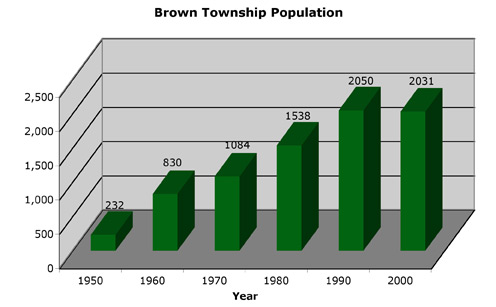Brown Township, Ohio
Who was here before me?
Before Brown Township even had a name the Haudenosaunee (Haw-de-no-saw-nee) Indians lived there. The Haudenosaunee, along with the Shawnee Indian leader, Tecumseh fished along the Big Darby Creek, which used to be known as Crawfish Creek. Why do you think the native people of Brown Township called it Crawfish Creek? Jonathan Alder also spent most of his life along Crawfish Creek (Big Darby Creek).
Many of the first people to live in Brown Township were settlers from Virginia, this area had been reserved for them because they were soldiers. Some of the first families to move to Brown Township were the families of John Hayden, William Walker, James Langton, and Paul Alder (whose grandfather was Jonathan Alder). Many of these last names may sound familiar since they are used as road names in the area today.
What do families need when they move? A house, of course! Henry Alder built the first wooden framed house in 1834. Before the framed house most houses were build from the outside in. A framed house is just like it sounds; you build a frame for all of the walls inside and outside and then you make them solid. This is how houses are built today. Henry Francis built the first brick home, which is still standing today. You can see this house on Amity Road.
Goods and Services
Since Brown Township served as its own town, separate from Hilliard, it needed many goods and services for the people living in the smallest township in Franklin County.
Sawmills:The Big Darby Creek was the major source of energy for the sawmill built in 1837 by Isaac Hayden. A sawmill was used to cut large pieces of wood to use on the railroad. The second sawmill was powered by steam.
Railroads: built by John Reed Hilliard. The first train arrived at Brownson Station (sometimes spelled Bronson) on July 4, 1853. The last train left the station on May 18, 1948. When trains came through Hilliard, they ran into a BIG problem: COWS! The cows would be standing on the track and the trains would seriously injure or kill the cows. One day when J.R. Davis was riding a train through the area, he saw what a problem cows on the tracks could be. He also saw a farmer plowing a field and that gave him an idea! He invented a cowcatcher. This device was attached to the front of the train and it would sweep the cows away from the track. These cowcatchers became a feature on trains all over the world.
Blacksmith shop: operated by: William Michael.
Doctor:Dr. John Rathbun was the first physician (doctor) to have his office in Brown Township in 1839.
Store: Operated by Sylvester Brown. On March 3, 1830 Brown Township was named after this first store owner.
Post Office: Joseph O’Harra was the first Brown Township Postmaster. The post office was built on Amity Road in July of 1848.
Getting an Education
How would you like to go to school in a log cabin? That’s what many of the first children of Brown Township did. The first school house was opened in 1820.
Before Brown Elementary was built, one of the first one-room schoolhouses was built in Brown Township. This one-room school house was built in 1840 and was named the Wales school.
Since Brown Township has many acres of land there were once several schools scattered around the area. There were several schools because students had to get there easily. Students did not ride buses to school in the 1800’s. If not by bus, how do you think the students got to and from school?
Population

Government
Brown is a township. All Ohio townships with unincorporated territory have Boards of Trustees.
Townships provide basic services to residents, unless villages or cities assume some of those duties in the incorporated areas. Typically, municipalities have assumed and exercised authority for planning, zoning, law enforcement and street and road maintenance. Many cities today still rely on townships to provide fire and emergency medical services.
Townships have authority to purchase or appropriate land for a cemetery, sell plots, set fees for services, and maintain and expand the cemetery.
More Information & Primary Sources
- Primary
- Articles
- Image
- Charts
- Artifact
- Link
- Map
References
Written by Stephanie Richey, 3rd grade Brown Elementary

